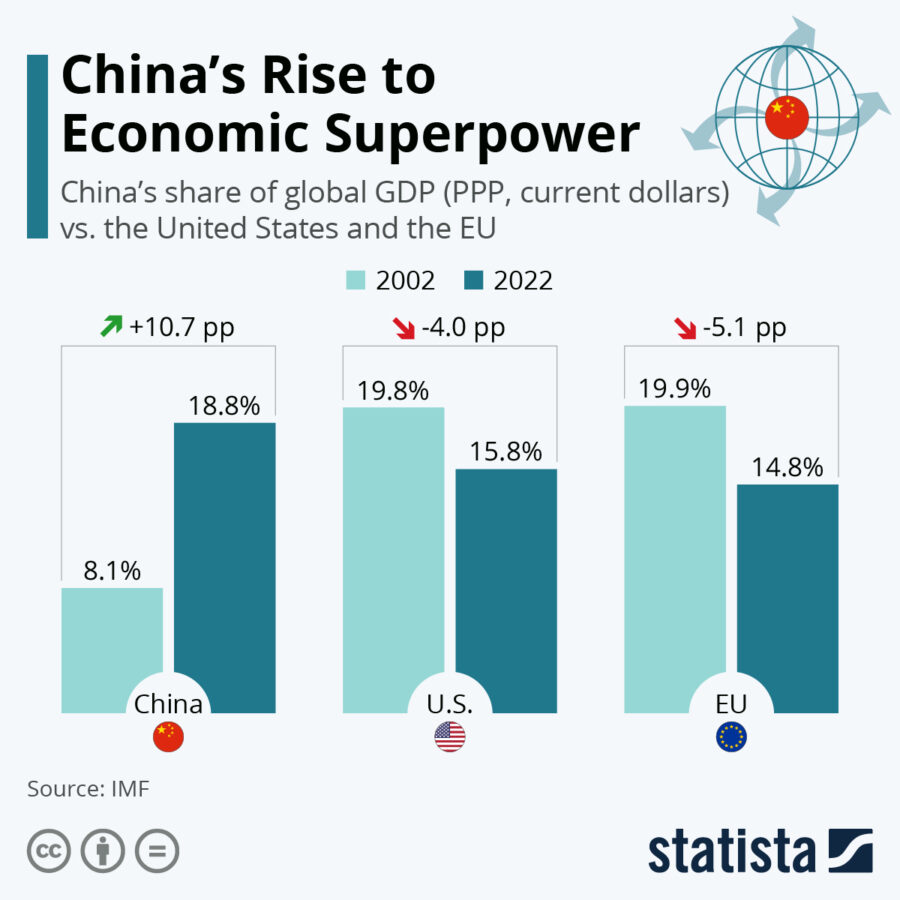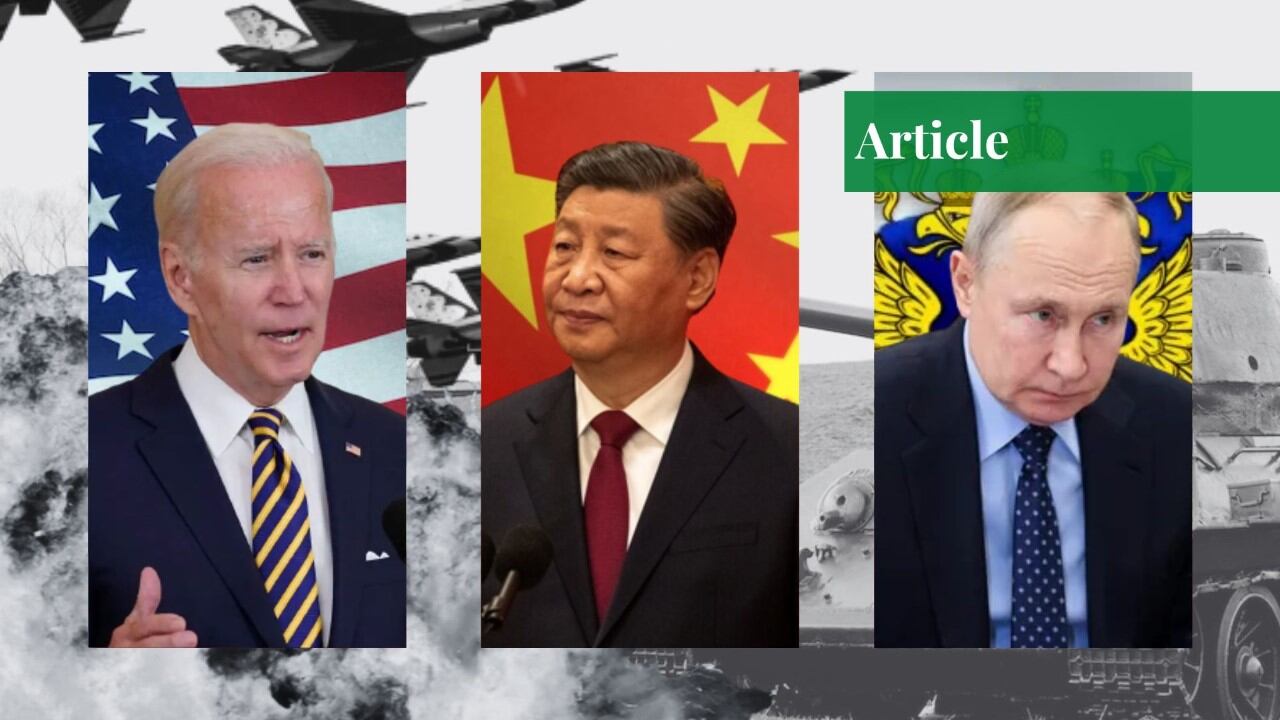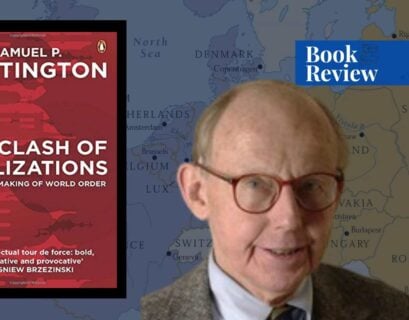Sarmad Ishfaq is an independent researcher and writer whose work has been published by Harvard Kennedy School Review, The Diplomat, Open Democracy, Paradigm Shift, Mondoweiss, and Eurasia Review to name a few. He has also been published by several international peer-reviewed journals such as Taylor and Francis' Social Identities. Before becoming an independent writer, he worked as a research fellow for the Lahore Center for Peace Research. He has a master's degree in International Relations from the University of Wollongong in Dubai where he was recognized as the 'Top Graduate'.
Introduction
The international world order as it currently stands is in a state of flux. In this impetuous environment, a clash between the US, an aging giant desperately holding on, and China, an emergent power hopeful for its coronation, is indeed imminent. This is what history has taught us as has nature. In the aftermath of this forthcoming great conflict, a new king will be crowned and a new world order brought forth.
I state two important facets that explain why the world is headed towards such a conflict. The first is how American hegemony is waning. This section discusses the political, military, and societal failures of the US as well as Chinese inroads. The other facet is a recent one specifically deliberating on the China-Russia-led de-dollarization project which is undermining the global reserve currency, the dollar. The last section explains why the environment created due to these facets will lead to the collapse of the US and the rise of China, thus bringing a new world order.
Waning American Hegemony
The American empire has not only peaked but is on the descent. This is best reflected by how different countries are behaving with the superpower or behaving with its opponents. The US’s failures in Iraq and Afghanistan, societal dichotomies, and the rise of China have shown that the once ineluctable shadow of US hegemony is rapidly dissipating.
Internal Rifts
In the last few years, the US’s domestic issues have left the world in perennial consternation. The George Floyd murder and riots displayed to the world that US racial fractures are still abundant; the plethora of gun violence and lone gunmen shootings reflect poor American policies and safety; neo-Nazi militias juxtaposed to all-black militias mirror something from a dystopian third-world country while the Capitol Hill insurrection is indicative that perhaps the US is now just a house of cards.
Most of these domestic quandaries and others such as student debt, abortion, and universal health care can be boiled down to the raucous left vs right divide. Things became so volatile during and after Trump’s presidency that it was commonplace to find articles or videos on a brewing US civil war – shades of which the world has witnessed.
Unfortunately, these fissures in American society and the people’s psyche endure even after Joe Biden’s election win – and will remain due to their deep-rootedness. The most recent polls indicate that 57% of Americans disapprove of him and many of his supporters would not want him re-elected. While he was an insipid Democratic candidate during the elections, the left rallied behind him simply because of their animosity towards Trump, not due to any redeeming quality of his.
Juxtaposed to the left, Trump’s supporter base, i.e., conservative Christians and Evangelicals, remain vocal and even frantic for his triumphant return to the presidency which they feel he was robbed out of (alleging electoral fraud). Trump’s recent arrest will provide further impetus to his supporters and his anti-deep state narrative; he will be a serious contender for the 2024 elections if freed.
Military Failures & Foreign Relations
Apart from internal strife, American influence amongst other nations has also plummeted. For example, in the Middle East and South Asia, mistrust of the US is at an all-time high. The atrocious and prodigal invasion of Afghanistan cost around 2 trillion dollars and more importantly, led to the deaths of an estimated 70,418 civilian deaths (in Pakistan and Afghanistan).
The harrowing optics of the severely handicapped Taliban breaking the US Goliath’s back showed that American omnipotence is merely illusionary. Pakistan, a formerly key US ally, has also seen the error of its ways. Joining the War on Terror led Pakistan into the flames of insurgency that had to be put out by many sacrifices.
The ignominious war in Iraq, founded on false pretenses, not only destroyed a relatively stable country but also created an incubator for the menace of ISIS. Around 300,000 people in Iraq died due to the US, its allies, or the Iraqi security forces from 2003 until March 2023. While Putin is made out to be the next Hitler by the media, Bush and Obama, the latter winning a Nobel Peace Prize, were never even tried for war crimes – exposing American hypocrisy.
The post-9/11 wars have been lethal for the Middle East and South Asian region with almost a million people dying including 387,000 civilians. Syria, Yemen, and Libya have all suffered due to American interference and proxy wars. Furthermore, American submission to Israel is palpable and exhibited by the absence of any inimical action against Israeli transgressions. Instead, the world is subjected to selective American outrage and hackneyed pontification vis-à-vis Chinese wrongdoings in Xinjiang and Russian violations in Ukraine.
Even robust allies such as Saudi Arabia have realized that anyone is dispensable to American interests – save Israel. Hassan Awad, a US-based expert on the Middle East states that the US allowing “…a close ally like Hosni Mubarak to fall [in 2011] was a shock to leaders in Riyadh, Abu Dhabi, and elsewhere…,”.
The China Factor
China’s ambitious Belt and Road Initiative, the Shanghai Cooperation Organization, and its massive exportation of goods have created an economic dependency on the country for most. While countries like Russia and Iran, which are vehemently anti-US, are proudly in the Chinese camp, other countries have expressed their commitment to non-alignment.
Countries such as Japan and India who have had historically frosty relations with China cannot isolate themselves from the rising power. Japan, for example, has committed to the BRI even if done cautiously. India which has long-standing border disputes with China, which have worsened in recent years, is engaging with the country as much as it can including via BRICS. While the BRI has had its fair share of ups and downs, studies show that it has vastly improved China’s soft power.
For the first time ever, more people in developing countries prefer China over the US. This is especially true for the BRI-supported countries where almost two-thirds of inhabitants hold a favorable view of the country. This is symptomatic of how the BRI is not only an economic endeavor but has been skillfully leveraged by the Chinese as a diplomatic and political tool.

The extent of China’s influence was highlighted in the Saudi-Iran détente which completely blindsided the US. With respect to trade too, China is an indefatigable juggernaut. It is the leading trade partner of over 120 countries. Its trade in Africa, for example, stands at around $261 billion – four times more than the US’s. Chinese trade with other integral US allies such as Saudi Arabia has completely dwarfed US-Saudi trade as well.
According to a Brookings Institute policy brief, “The new non-aligned countries in South Asia, the Middle East, and parts of Africa repeatedly say they do not want to have to choose between the United States and China.” Even reliable US allies like Germany, have been unable to decouple from China as much as the US has wanted.
A caveat here is important: this “non-alignment” does not mean that such countries have become absolutely pro-China and abhor America but instead remaining non-aligned bodes better for nations. However, even this much is a huge defeat for the US and signals its ongoing diplomatic downfall.
China, Russia, and the De-Dollarization Endeavour
The Russia-Ukraine war and impetuous Western sanctions on Russia have had ill-fated consequences on the US and its European allies. It has catalyzed the process of subverting the once ubiquitous US dollar – also known as de-dollarization. The West’s pressure and a supercilious crackdown on Russia – from removing the country from SWIFT to freezing its dollar assets – has allowed the China-Russia alliance to bolster further, economically and otherwise.
In Russia, the yuan has now become the most traded currency. Trade between both countries reached a record high of $190 billion last year with most of these payments made in their respective currencies. Furthermore, China and India became the two biggest importers of cheap Russian hydrocarbons after the war started which has kept Russia afloat. In his recent meeting with President Xi, Putin exclaimed that he is in favor of using the yuan for settlements between Russia and countries across Asia, Africa, and Latin America.
Due to the US’s iniquitous weaponization of the dollar, witnessed with Russia and previously in the unilateral sanctions placed on Iran under Trump, many countries are following China and Russia’s lead. China and Europe are in the process of building an alternative to the SWIFT system while India is using non-dollar currencies to settle oil purchases from Russia. Saudi Arabia is also flirting with the idea of the petroyuan in contrast to the default petrodollar.
On April 1, 2023, India and Malaysia also agreed to settle trade in Indian rupees while UAE and India are in talks of using the Indian rupee to settle non-oil trade. Furthermore, Malaysia has revived a decades-old plan to introduce an IMF alternative called the Asian Monetary Fund. The Malaysian PM has said that there is no reason for the country to continue depending on the dollar, with China welcoming this move.
Most ambitiously, however, has been BRICS’s desire to introduce a new currency altogether. Alexander Babakov, deputy chairman of Russia’s State Duma explained that the nations were in the process of introducing a currency backed by gold and other rare-earth materials. This would be a drastic change as no country in the world today uses the gold standard. Furthermore, the rise of cryptocurrencies, being explored by many countries including China, has decreased dependency on traditional fiat currencies.
All the above factors combined have led to the contraction of dollars in global central bank reserves which has dropped from around 70% 20 years back to less than 60% today – and continues to descend steadily. In America itself, the economy is not the bulwark that it once was. Three banks recently collapsed and furthermore, the growing cost of food and fuel, due to the Ukraine war, might signal that the worst is yet to come. While the dollar has had its share of vicissitudes in the past, it has perhaps never been challenged this much, especially exogenously.
The Order-Changing War
“While the United States remains a global political, economic, and military giant, it no longer enjoys an unassailable position versus state competitors,” as aptly stated by a 2017 study published by the US Army War College. Concurrently, if left to its economic machinations, China will overtake the US in all spheres, including militarily. This is the capricious global abyss that the world is currently peering into – one which will eventually force a catastrophic US-China conflict that will change the established world order.
This is what billionaire Ray Dalio also explains in his meticulously researched book – abridged in this video. He states that all empires have a rise, a peak, and a decline (America being in the latter). The decline is marked by a financial burst and internal economic weakness which leads to more printing of money. It is also marked by internal strife between the rich and the poor as well as costly external fighting or both (sounds very familiar). This he says leads to a revolution in that superpower (usually of a violent nature) that aims to redistribute wealth.
This domestic chaos makes the empire weaker and susceptible to a new rising power, in this case, China. Eventually, a major conflict will ensue between China and the US which in its wake would establish a new great power and a new world order. This explains Mr. Dalio has happened with many empires throughout history including the Dutch and British – WWII being the latter’s last conflict as king.
The US recognizes that it could be yet another victim of history and great cycles. However, there is no perceivable way that it will ride peacefully into the sunset and let China or any other competing power fill the void. Perhaps this is a case of a self-fulfilling prophecy. “Something’s gotta give,” as they say. The recent budget request pushed by the Pentagon to Congress, amounting to a whopping $842 billion, is, according to Defense Secretary Lloyd Austin, “…driven by the seriousness of our strategic competition with the People’s Republic of China,”.
In simpler terms, the US perceives that a conflict with China or a China-Russia-led bloc is imminent. While the US is persistent in propagating that it is the Chinese that want war with the US, their own actions seem contrary to this. For example, the indignant and irresponsible decision to send Nancy Pelosi to Taiwan appeared to be an instigation – perhaps the US wanted its other archnemesis to be stuck in a war as well. This move has led to more Chinese naval ships and military drills near Taiwan and a greater chance for a direct showdown between Chinese and American war vessels.
Similarly, the world is one wrong move away from NATO including the US getting directly involved in the Russia-Ukraine conflict. Finland has joined NATO while Putin has been threatening nuclear retaliation if the crisis escalates. This is why the famed Doomsday Clock is currently set at 90 seconds to midnight – the closest it has ever come to global catastrophe.
Final Thoughts
Sooner rather than later, the global powers will engage in a quest for supremacy. Whether this is WWIII or something else is uncertain but in my opinion, American hegemony will conclude. In fact, it is quite probable that while engaged in the aforementioned conflict, the current fault lines in American society rupture leading to internal conflict or a civil war.
Akin to how the Ottomans lost their territory after WWI, or how the British lost its colonies after WWII (both faced internal and external conflict simultaneously), the states within the United States will become bereft.
If you want to submit your articles, research papers, and book reviews, please check the Submissions page.
The views and opinions expressed in this article/paper are the author’s own and do not necessarily reflect the editorial position of Paradigm Shift.



















